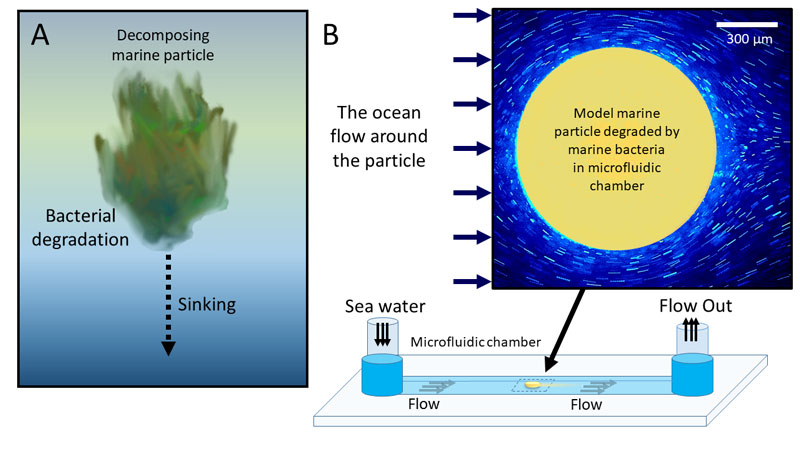Tiny photosynthetic microorganisms that drift in the world’s oceans absorb from our atmosphere the very same carbon dioxide that we humans overproduce during our everyday life. These countless microorganisms, mostly composed of single-cell algae and cyanobacteria, absorb about 50 Gt of carbon into their biomass every year and serve as the basis of the food web for the entire ocean. When their life ends, these phytoplankton tend to aggregate to form organic particles, either by colliding and sticking together, or when excreted after being eaten by predators. These particles then sink, but as they sink, they are subjected to fragmentation by microscopic planktonic animals and degradation by bacteria. Although this may sound like an obscure story about the afterlife of dead algal clusters as they sink into the dark blue ocean, this is in fact a crucial process of Earth’s climate — the sinking of this marine snow is responsible for taking the carbon dioxide that was absorbed from the top of the water column and locking it in the deep oceans for thousands of years, with a major impact on the concentration of carbon dioxide in our atmosphere.

Figure 1. Model system to examine the effect of sinking on bacterial degradation of marine particles. A. Marine organic particles are degraded by bacteria as they sink, releasing carbon that would otherwise be stored in the oceans’ depths. The main goal of our study was to determine whether sinking itself affects the rate at which bacterial degradation occurs. B. We designed a model system in which flow around a stationary particle mimics sinking of a particle through the ocean water column, allowing us to measure degradation rates under the microscope. In this system, instead of the particle sinking through the ocean, the ocean flows around the particle. Inset: false-color image of a particle (light orange circle) under flow of seawater and bacteria (small specks around the particle).
Known as the biological pump, this global-scale process is controlled by many factors, but at its core are two opposing forces: particle sinking and microbial degradation. The faster a particle sinks, the more carbon is delivered to the deep ocean, whereas faster degradation of particles causes more carbon dioxide to be released in the upper water column, ultimately accelerating the return of carbon dioxide to the atmosphere. Our study examines whether or not these two facets of the pump are coupled. Or in simple terms: are particles that sink faster also degraded by colonizing bacteria faster, more slowly, or is the speed of degradation independent of the sinking speed? The answer to this question will give scientists a deeper understanding of the oceanic carbon cycle, with implications for the development of future global ocean models with greater predictive power.
Taking microscopy to the oceans to observe the breakdown of those sinking particles is extremely challenging, so instead we brought the ocean to the laboratory. We built a model system in the laboratory that mimics the dynamics of a sinking particle. A breakthrough happened when we realized that by trapping a model particle in the middle of a microfluidic channel while pushing a flow of ocean water around it, we could easily and reproducibly mimic the sinking of a particle through the ocean water column. By changing the reference point of the experiment, we could thus precisely monitor under a microscope the degradation by bacteria of a stationary polysaccharide particle while flowing the ocean around it (Figure 1). This also allowed us to test the effect of different sinking speeds on degradation by simply controlling the flow rate of the system. Remarkably, our suspicion that the sinking and degradation of particles are dependent on each other turned out to be correct — we were able to show that sinking enhances the degradation of particles by about 10-fold compared to particles that do not sink. This finding was confirmed in experiments using different polysaccharides that are regularly found in marine particles and when using different model marine bacteria, indicating that this enhancement of degradation may be a general feature of the dynamics of particles sinking in the ocean. Finally, a new model of carbon transport that we developed suggests that sinking-enhanced degradation can make a major contribution, together with other mechanisms, to the overall magnitude and shape of the oceanic carbon pump.
There is still a long way to go before scientists fully understand the complexity of the oceanic carbon cycle in its full glory. However, with the help of HFSP, our study was able to demonstrate that by using microscopic observation, at the scale of an individual particle in the ocean, scientists may infer fundamental driving forces that shape global-scale biogeochemical cycles.
Featured in the media
Science News and Views
Faculty Opinions
ETH Zurich news - A Glimpse into the ocean’s biological carbon pump
Mirage News - New model of ocean’s biological carbon pump
Futurity - New research sheds light on how oceans absorb carbon dioxide
Phys.org - A Glimpse into the ocean’s biological carbon pump
True Viral News - A glimpse into the ocean's biological carbon pump
|
HFSP award information Long-Term Fellowship (LT001209/2017-L): Unraveling the microscale mechanisms driving particle degradation in the ocean |


































